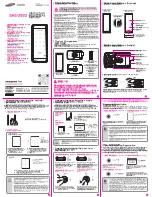
Subject to change.
Roto Safe E601 – Eneo AF
IMO_66_EN_v2 / 104674
.
August 2019
.
3
Installation and maintenance instructions
Maintenance instructions
The door manufacturer must draw
builders and end user’s particular at-
tention to these maintenance instruc-
tions.
In the event of non-compliance of this
advice, faultless system operation can-
not be warranted.
The following maintenance instruc-
tions shall be adhered to not less than
once a year – and also more often de-
pending on use:
The end user
must lubricate:
- Lubricate all movable parts and all
locking points of the locking system
must clean:
- The strikers may not be clogged up
or blocked.
- Use only cleaning and maintenance
agents that do not compromise the
corrosion protection of the hardware
components.
must check positioning and opera-
tion:
- Check movable parts on all locking
points for correct operation.
- Check that the lever-handle set is
mounted securely.
- Check that safety-relevant hardware
components are mounted securely.
- Examine safety-relevant hardware
components for wear and tear.
- Tighten fixing screws if necessary.
may not paint over:
- Do not paint over the lock (faceplate)
and/or the locking components.
shall notify a specialist if need be!
Only the specialist may:
Carry out work on the locking sys-
tem and respective hardware com-
ponents.
Replace components.
Replace fixing screws if necessary.
Testing the door
Check the system if it corresponds to
the list of original, approved supplied
components.
Check the door for prohibited retro-
fitted locking devices.
Test the emergency exit mode of
operation
Test the emergency exit mode of
operation at regular intervals.
Using a force gauge, measure the
operating forces that need to be
applied to release the emergency exit
lock, record this and compare it to the
clearance levels from the initial instal-
lation.
Installation instructions
Caution!
The emergency exit
lock is not suitable for use on
swing doors.
Avoid possible safety hazards when
using the emergency exit lock on
doors with stepped surfaces, e.
g. fin
-
gers or clothing getting trapped.
When using the emergency exit lock
on glazed doors, the glazed parts must
be made of safety glass or laminated
safety glass.
Emergency exit locks should be ap-
plied where the width of the escape
route is limited or the doors on which
the locking mechanisms are installed
can only be opened 90°.
The protrusion of the blocking ele-
ments may not impede the door’s free
movement.
Only the blocking mechanisms, strik-
ers and hardware, that were tested
together with the emergency exit lock
may used be.
Prior to installation:
– Ensure that the door has been pro-
duced and fitted correctly.
– Ensure that the door is not warped.
– Ensure that the door leaf and frame
run parallel to each along over the
entire height.
– Remove all impurities from the
routed area.
– Check the clearance – timber:
4 mm uniformly all round.
– Check the clearance – PVC:
12 mm uniformly all round.
– Check the clearance – aluminium:
uniformly all round in compliance
with the profile manufacturer’s spe-
cifications.
Installation
1. Crop the faceplate in line with the
door design.
2.
Screw fix the faceplate with Ø 4
mm
screws at right-angles to the face-
plate.
Use the appropriate fixing material for
fixing an emergency exit lock on tim
-
ber, PVC or metal doors.
Use through bolts for solid lever-
handle fixing.
Ensure that both the latch and all lock-
ing components close softly.
Profile gaskets may not hinder the
smooth
functioning of the emergency exit
locking mechanism.
When installing a door closer, bear in
mind that the door operation for chil-
dren, the elderly and the disabled is
not unnecessary hindered.
Marking
Attach the marking on the inside of the
door directly above the lever-handle:
either as a sign with the inscription
“Turn the handle to open” or a picto-
gram.
The pictogram should be min. 80 cm²
, and white on a green background.
Upon completing the installation of the
emergency exit lock, the arrow shall
point to the lever-handle.






















